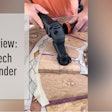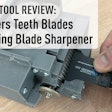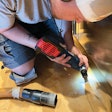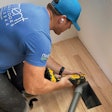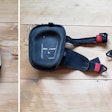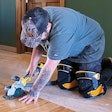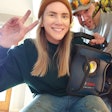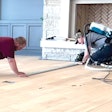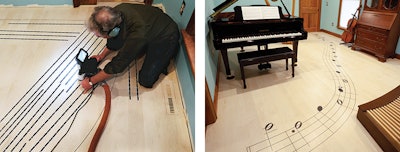
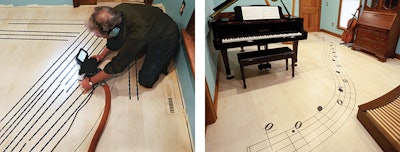


Shaper Tools' Origin Hand-Held CNC Machine
Mark Scheller of Scheller Hardwood Floors in Lemoyne, Pa., reviewed the new hand-held CNC machine from Shaper Tools:
Unlike traditional CNC routers, which are attached to a gantry system bolted down to some distant shop floor, the Origin is completely portable and can be used in the field on an installed floor. I've been using the Origin for over four months now, and it's been a game-changer. Using the Origin, jobs that would have been difficult or even impossible for me to do have been, while still a challenge, relatively easy and even fun.
The tool works by scanning the special Shaper Tape, which looks like dominos and is placed on the floor, and compiling it into a map. The Origin then becomes like a computer mouse to place the design virtually on the work surface with the click of a button. Once the design is placed, a cut line is chosen and the operator guides the tool following a target on the screen, staying within about a half inch of the line, and the tool does the rest.
The spindle is custom-made by Festool exclusively for Shaper. It's small (the size of a trim router), but very robust and built to run all day. The rest of the Origin is equally impressive, with clean lines, comfortable handles, and an intuitive user interface. The goose-egg-shaped handles are low enough so I can extend a finger and maintain contact with the work surface, which I like. The low center of gravity and large base plate for a router this size makes it well-balanced and easy to control. The dust collection is far better than most of my other (seven!) routers.
The Origin is really two tools built on one platform. It's also a powerful computer that guides the CNC component with repeatable accuracy to the thousandth of an inch. To get the most out of it, and I'm only beginning to do that, I had to learn some CAD drawing skills. The first project I did, the compass rose star, I designed using Fusion 360. After a few YouTube videos, it was actually pretty easy, and I was able to get exactly what I wanted. The seams between the pieces were nearly imperceptible, and cutting the circle for the brass "free hand" seemed like magic. The accuracy where the miter cuts meet in the middle exceeds anything I was capable of previously.
The next big project was the Music Room Floor, which I hired a graphic designer to draw. The project was so big, in fact, that Shaper had to rewrite the tool's programming to accommodate it. Without my asking, they did that in three weeks, and my tool, along with everyone else's, was updated seamlessly over Wi-Fi. I believe a quick response speaks volumes about the company's drive to make the operation a good experience for the user. Since then they've sent out another update, just in time to use on my current project, a floor made up of curved trapezoidal panels where each panel will be a unique shape.
I use the Origin two ways: directly on the floor and on a bench with a recessed area to make the design components and other things like templates and tools. The object being cut has to be flush with the work surface where the Shaper Tape is applied. Cutting things on a dedicated bench is nice because the Shaper Tape doesn't have to be changed. I hold the pieces to the bench using spray contact adhesive (a trick I learned from Dave Marzalek). I thought the Shaper Tape would be expensive, but that turned out not to be the case. For the Music Room Floor where the design element is over 16 feet long, I used about $22 worth of tape.
I believe the Origin will put CNC capabilities in the hands of a wide audience and is particularly well-suited to the custom floor trade. In fact, I feel that we wood floor artisans were the customers they had in mind when they designed it. At its price, the Origin can pay for itself in one or two good jobs, and from there it opens up a world of up-until-now unimagined possibilities. I believe this tool is the future of custom flooring.
Retail price: $2,499 (to find out when sales will open again, go to preorder.shapertools.com)
See Mark Scheller running the Origin:

Senco's Whispergrip Subfloor Nails


Jorge Perez of Epic Hardwood Floors in Tacoma, Wash., tried the new Senco WhisperGrip subfloor nails with a Senco SCN60XP coil nailer:
When I do subfloor prep and install new plywood subfloors, like most pros, I always use screws and an impact driver. So, I was interested to try the Senco WhisperGrip subfloor nails and a nailer instead. The company says the nails have "a patented step ring design that was originally developed in collaboration with the manufactured housing industry to better grip subfloor and sheathing material, maximize holding power, reduce squeaks, and eliminate costly callbacks" (sounds like a tall order). The nails have the company's Sencote coating, which it says acts as a lubricant during the drive, then becomes an adhesive once driven. So these aren't your typical nails. The company sent its Senco SCN60XP coil nailer to test the nails, although the nails work with any coil nailer.
The first job I tried this on was a project where I had to secure shiplap that was loose and squeaky; in fact, the squeaks were one of the first things the homeowner pointed out to me when we first walked the job. The nailer holds so many nails (up to 275) that one coil was enough to secure 400 square feet of the loose shiplap, and it was very easy to load. The depth was easy to adjust with my thumb, and it sunk the nails perfectly at a depth just below the subfloor. It was very precise while also feeling like a rugged tool. It was a huge time savings and much physically easier to just shoot the nails instead of having to drive all the screws. Once I took off my hearing protection and walked the floor, I was amazed that there were no squeaks. I installed solid strip flooring over it, and the next day the homeowners were like, "Wow, no noise!" I was like, "Jackpot!"
The next time I used the nails and nailer was for a tile installation with a loose subfloor, and I had the same results. I would say these nails and this tool definitely do the job they were designed to do. Speed and ease of application are key in our industry; using this combination on all my jobs would definitely make my life and business better and keep me from "screwing" floors up!
Retail price: $325 for coil nailer; $250/box of 4,000 WhisperGrip nails
See what Jorge has to say about these tools:
Would you like to be considered as a tool reviewer for WFB? Contact the WFB editors.
See other tool reviews:
Tool Reviews: Cordless Circular Saw, Cordless Orbital, More
Tool Reviews: Cordless Rear-Handle Circular Saw, Worm Drive Table Saw
Tool Time: Comparing Laser Distance Meters


















